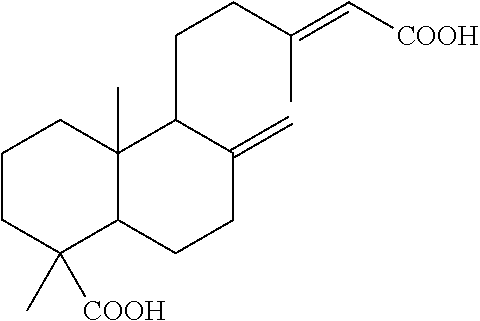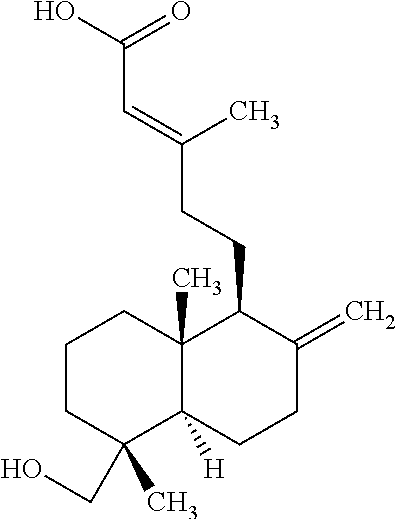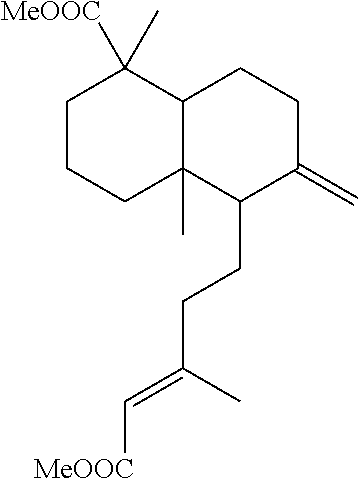Use of a Copaifera extract to combat alopecia and seborrhea
a technology of alopecia and seborrhea, which is applied in the field of using a i > copaifera /i > extract to combat alopecia and seborrhea, can solve the problems of no evidence of preventing hair loss, strong and unpleasant smell, bitter and pungent taste, etc., and achieves the effect of beneficial dermatological and cosmetic properties
- Summary
- Abstract
- Description
- Claims
- Application Information
AI Technical Summary
Benefits of technology
Problems solved by technology
Method used
Image
Examples
example 1
f Different Compounds on the 5α-Reductase Activity of Fibroblasts Derived from Human Follicle Dermal Papillae
[0070]The objective of this study was to evaluate the potential inhibitory activity of different compounds on 5α-reductase.
Materials and Methods
[0071]The study is performed on human cells derived from donor follicle dermal papillae. This model is attractive since dermal papillae have the 5α2 isoform as in prostate tissue. The cells are seeded in 24-well plates and cultured for 24 hours in DMEM culture medium supplemented with L-glutamine (2 mM), penicillin (50 U / ml), streptomycin (50 μg / ml) and fatal calf serum (10%) under standard culture conditions (37° C. and 5% CO2). The culture medium is then replaced by a DMEM analytical medium supplemented with L-glutamine (2 mM), penicillin (50 U / ml), streptomycin (50 μg / ml) and fatal calf serum (1%). This analytical medium may contain or may not contain (control conditions) the products to be tested and a compound used as reference, ...
examples
Preparation of Oleoresin
example a
[0091]The trunk bark of Copaifera officinalis and / or Copaifera multijuga and / or Copaifera reticulata trees is notched to recover the oleoresin. This is then homogenized and stabilized under nitrogen.
[0092]The active substance is 100% raw oleoresin from the trunk of Copaifera officinalis and / or Copaifera officinalis and / or Copaifera. multijuga and / or Copaifera. Reticulata.
[0093]LCMS Analysis of a Copaifera officinalis Oleoresin:
[0094]Each sample was analysed by UHPLC-QTOFMS using a conventional linear gradient. Separation on a Waters Acquity UHPLC system.[0095]Column 100×2.1 mm, 1.7 μm, Acquity BEH C18 equipped with a pre-column[0096]Mobile phase:
[0097]Mobile phase A: LCMS grade water +0.1% formic acid
[0098]Mobile phase B: LCMS grade acetonitrile+0.1% formic acid
Gradient
[0099]
Time (min)% A% B 0-0.550500.5-4 50 → 4050 → 60 4-1240 → 1 60 → 9912-15 199 15-15.5 1 → 5099 → 5015.5-19 5050
[0100]Acquisitions: UV 220 nm
[0101]
Content in theoleoresin(weight % relative tothe weight ofStruct...
PUM
 Login to View More
Login to View More Abstract
Description
Claims
Application Information
 Login to View More
Login to View More - R&D
- Intellectual Property
- Life Sciences
- Materials
- Tech Scout
- Unparalleled Data Quality
- Higher Quality Content
- 60% Fewer Hallucinations
Browse by: Latest US Patents, China's latest patents, Technical Efficacy Thesaurus, Application Domain, Technology Topic, Popular Technical Reports.
© 2025 PatSnap. All rights reserved.Legal|Privacy policy|Modern Slavery Act Transparency Statement|Sitemap|About US| Contact US: help@patsnap.com



